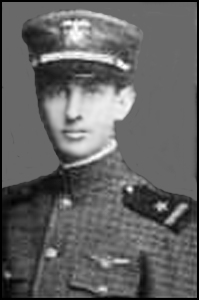
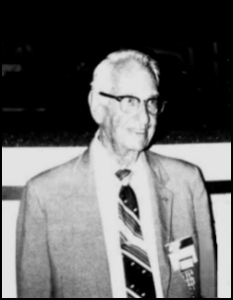
|
1894-1992 |
 |
 |
||
| Start of WW I | 1985 |
|
FORREST E. WYSONG'S FLYING CAREER "I'm going to be a locomotive engineer. Four of my uncles were engineers and that's what I want to do also", replied Forrest. "What are you going to do?" "Well, I have been reading about flying and I want to be an aviator. Boy, that would be a thrilling life. "Yes, I guess it would. I never thought much about it." "Why don't you come by my house and let me show you a book about airplanes and some magazines I subscribe to." And that began it for Forrest Wysong. He also subscribed to the publication, AERO, and became an avid follower of the doings of the Wright Brothers, Glenn H. Curtiss, Charles F. Willard and others, both American and foreign, who were rapidly following in the footsteps of these daring pioneers. |
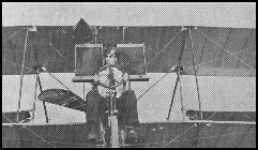 |
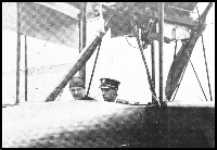 |
|
| CURTISS TYPE PLANE BUILT AND FLOWN BY FORREST WYSONG |
WYSONG AND A STUDENT IN CURTISS F-BOAT |
|
In 1914, while a Senior at North Carolina University, Forrest, with the aid of four other students, built the Curtiss-type plane he had been
planning on. In it they installed a six cylinder 74 h.p. Roberts engine, which they had bought second hand, including an eight foot
propeller, twin radiators and gasoline tank for $450. One of the students who assisted in assembling the airplane and rigging it was
Gurden L. Tarbox, who later became a member of the Early Birds of Aviation. He had
already taken flying lessons and had soloed in 1911, so was competent to give advice and encouragement when Wysong,
after a number of grass-cutting runs, made his first solo flight on March 16, 1915 from a field west of Raleigh, North Carolina.
Other flights followed. Tarbox also used his influence to help Forrest in getting a job with the Curtiss Aeroplane Company in
Buffalo upon graduation. On March 30, 1916, he was commissioned Ensign and during the Spring and Summer of that year gave flying instruction on the F Boat at the Naval Militia Air Station at Bayshore, N.Y. One of the students, Frank LaVista, eventually became a member of The Early Birds. In 1918, Wysong was sent overseas and served at various Naval Air Stations. When the armistice was signed, he was located in Brest, France. He returned to the United States in January, 1919 and was assigned as Assistant Aide for Aviation to the Commandant, Third Naval District, Brooklyn, N.Y. He terminated his active duty in June, 1919 with the rank of Lieutenant. When World War II came, he went into the Douglas Flight Test Division testing most of the Army, Navy and Commercial planes produced during that period. After the war, he continued as Flight Test and Research Engineer on commercial airplanes through the DC-8 model. |
|
You will find the complete story of the meeting, including a photograph of Forrest with other Early Birds standing in front of a replica of a 1912 Curtiss aeroplane at Hales Corner, Wisconsin. You can access the page by clicking on the title above |
|
You will find the complete text of the President's Address and a photograph of Forrest Wysong, President and my wife Jo Lees Cooper, Secretary, as they appeared at the meeting. You can access the page by clicking on the title above |
|
Interviewed by Jo Cooper - 1987 |
|
Interviewed by Jo Cooper & Dorothy Hole - 1987 |
|
|
|
|
| Forrest Wysong, Immediate Early Bird Past President, pioneer naval aviator, took his last flight 27 October 1992 in Norwalk, California. He was born in Cincinnati, Ohio 29 March 1894 and was 98 and the nation's oldest surviving naval aviator when he died in suburban Los Angeles. |
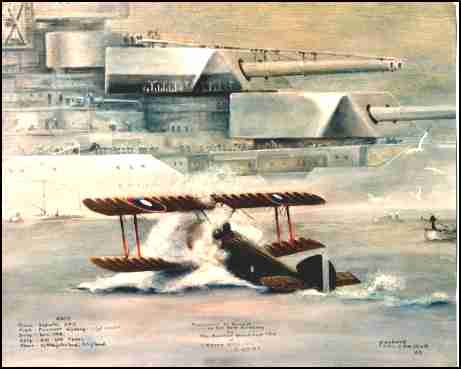 |
|
DATA Plane - Sopwith 2F.1 Pilot - Forrest Wysong - Lt(jg) USNRF Date - Nov. 1918 Ship - BB USS Texas Place - Killingsholme, England |
on his 90th Birthday by The Aviation Breakfast Club at Laguna Hills, Ca 3-25-'84 |
Cdr. USN (Ret) '84 |
Sharon Case-Magee, Forrest's grandaughter |
|
Forrest is believed to be the first American flyer to take off from a warship when he flew a single seat
Sopwith Scout off the primitive flight deck of the battleship Texas while cruising off Scotland during World War I. He was one of seven survivors of the Early Birds of Aviation Inc., originally a group of 598 men and women who flew by airplane, balloon, glider or airship before December 17, 1916---the 13th Anniversary of the Wright Brothers first powered flight. He was also a member of the OX-5 Aviation Pioneer Hall of Fame. In 1911 he built a working glider from mail-order book instructions. A crash ended this first phase of his flying. While he was a student at North Carolina State University, he built a Curtiss-type pusher biplane with a 75-horsepower engine and successfully flew it March 16, 1915 near Raleigh. In 1916 Forrest was commissioned as an ensign in the New York Naval Militia and assigned to fly a Curtiss Model F, a primitive flying boat. He was flying the N-9 seaplane when the U.S. entered WW I and was sent overseas aboard the battleship Texas. After WW I he worked in the Aerospace industry as test pilot and in engineering at Lockheed and Douglas, retiring in 1960. Later he had a successful career in investment securities. Forrest flew into his 90's. Ordered to active service with U.S. Naval Air Forces, April 6, 1917. Served as Naval Aviator at U.S. Naval Air Station, Bayshore, Long Island. Served on Naval Airport Program Committee from November 1917 to July 1918. Served overseas with naval Air Forces from July 1918 to January 1919. Stationed at Pauliac, St. Michel, Brest, Dunkirk and Killingholm. Decorations---French Croix de Guerre for shooting down German plane near Zeebrugge, World Overseas Medal and New York State War Medal. 

|